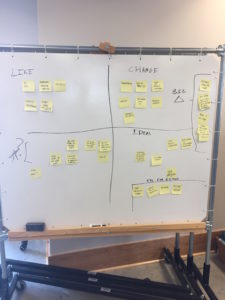Evaluating feedback in a systematic and productive manner is a key progression when improving upon an idea or concept. I found it very helpful to receive feedback from both our classmates, who were generally familiar with what we are working on, as well as from executive partners and the other class section. Through our other classmates, we were able to really hash out our prototype and improve upon any weaknesses that were identified. On the other hand, with people who were unfamiliar with our project, it was great practice to work on selling our idea. In order to do this successfully, we needed to be concise, direct and convincing. Furthermore, with people who were new to the idea, it was a very organic situation where people could speak on their initial reactions and thoughts. Having both written feedback and conversations with so many people was very revealing as to what we could work on going forward.
We began our evaluating process by reading through all of the feedback we received from the Friday expo. As we went through the handouts, we flagged any feedback that was constructive and tried to take notes on patterns as much as possible. After completing our initial screening, we created a larger feedback grid on a whiteboard, and posted sticky-notes that we deemed helpful. We were left with around 20-30 sticky-notes amongst the four quadrants and we made sure to combine any repeat ideas. There were definitely some recurring themes within the feedback, which made it pretty clear as to what we did well and what can be improved. One of the main critiques that we received was whether or not our frame needed to be a physical product, as opposed to a piece of software. In response to this, we decided to further segment our grid with a section of feedback that would require significant change, and a section for changes that could easily be added to our current model. We were left with the following result:

During our discussion, we talked about making a slight pivot in our idea. One feature of the Frames is that they have voice recognition, similar to an Alexa or Google Home. I found that during the expo when I explained our prototype as “Alexa with visual capabilities”, people really connected with and understood the idea. Initially, we weren’t planning on having the voice recognition as a primary feature, but rather a supplement to additional value added by the frame. We realized that if we were to change the prototype to focus more on voice recognition, that it would change our target market and how we were advertising the idea. Ultimately, we felt that this change would move us away from some of the initial problems that we were trying to address, which did not make a lot of sense. I do think it is something to consider moving forward, based on how favorably people were responding to it. Overall, the evaluation step has allowed us to look critically at feedback and decide how we can use it to improve our concept.